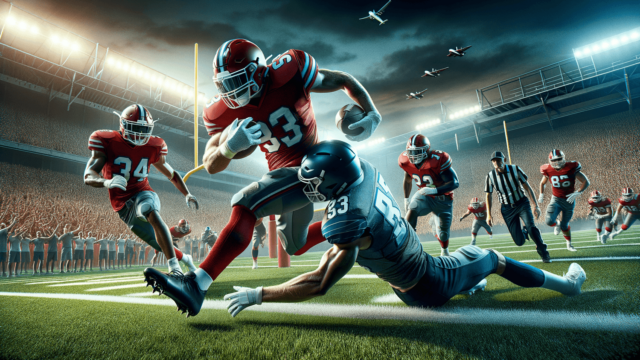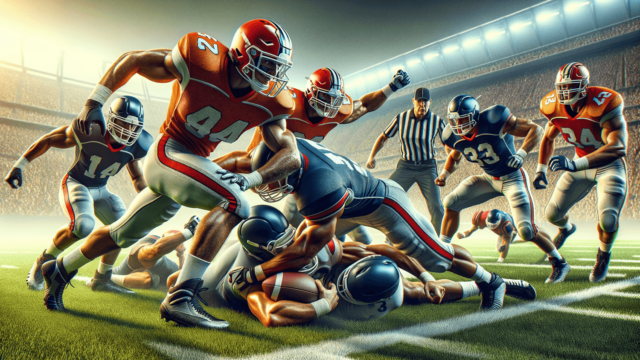
A pancake in football refers to a block made by an offensive player that completely knocks a defensive player down to the ground, often resembling a flattened pancake. This powerful blocking technique is commonly used by offensive linemen to clear the way for running backs and to protect the quarterback.
Understanding the Pancake Block in Football
A pancake block is an effective and powerful move in football executed by an offensive player, usually an offensive lineman, to neutralize a defensive player. This move aims to clear a path for running backs or provide protection for the quarterback during a pass play by knocking the opponent flat on their back.
Techniques for Executing a Pancake Block
There are three fundamental techniques used for executing a successful pancake block:
- Strong Shoulder Drive: The offensive player engages the defensive player with a powerful shoulder drive and a low pad level. The power generated from the hips and legs pushes the defender backward and off-balance.
- Hand Placement and Leverage: The blocker uses correct hand placement, gripping the inside of the defender’s shoulder pads, which gives them leverage to control the defender’s movements. Proper leverage allows the blocker to stay low and maintain balance during the block.
- Finishing the Block: The offensive player stays with the block, driving their legs and hips for momentum while simultaneously pulling the defender down with their hands. The end result is the defensive player getting flattened to the ground like a pancake.
Why Pancakes are Valuable in Football
A well-executed pancake block can be a game-changer for several reasons:
- Demoralizing effect: Successfully performing a pancake block on an opponent can instantly demoralize them and establish dominance for the offensive player, resulting in increased confidence and aggression on the field.
- Exploiting running lanes: Pancake blocks help create wider running lanes by clearing the way for running backs, increasing the chances of a successful rush or catching a pass.
- Protecting the quarterback: When offensive linemen can consistently pancake block defenders, it reduces the chances of sacks or forced turnovers, allowing the quarterback to function under less pressure, ultimately improving the team’s offensive performance.
Measuring Pancake Blocks in Gameplay
Although pancake blocks are not an official statistic in football, some coaches and teams may track them to analyze and assess an offensive lineman’s performance and dominance on the field. Pancake blocks can be a useful indicator of an offensive lineman’s ability to control the line of scrimmage, thereby contributing significantly to the success of the offensive game plan.
Notable Pancake Blockers in Football History
Throughout the years, several offensive linemen have gained notoriety as exceptional pancake blockers, contributing to their team’s success and earning individual accolades and recognition. Some standouts include:
- Anthony Muñoz: Widely regarded as one of the greatest offensive linemen in NFL history, Muñoz’s agility, strength, and technical skill helped him to consistently dominate opposition and provide solid protection for his teammates.
- Jonathan Ogden: Known for his size and power, Ogden was a force to be reckoned with during his career with the Baltimore Ravens. As an expert in controlling defensive linemen, Ogden was able to flatten his opponents with ease.
- Orlando Pace: A key player for the St. Louis Rams during their “Greatest Show on Turf” era, Pace’s mobility and dexterity made him an invaluable asset in both the rush and pass game, performing pancake blocks with unrivaled consistency.
Keys to Becoming an Effective Pancake Blocker
For offensive linemen looking to sharpen their pancake-blocking skills, there are several key elements to master:
- Stance: Adopting a solid stance, with a balanced position and proper alignment, is crucial for generating power and maintaining control as the blocking motion commences.
- Strength and Conditioning: Developing the leg, hip, and core strength needed to drive through opponents is essential for pancake blocking. Incorporating targeted strength training and conditioning programs into practice routines can aid players in building this physical foundation.
- Footwork and Agility: Quick feet and agility are essential components of successful pancake blocking. Offensive linemen must be able to move laterally and change direction efficiently to maintain optimal blocking position and engage defenders effectively.
- Mental Toughness: As pancake blocks can serve to demoralize the opposition, offensive linemen must be mentally tough and unyielding, displaying resilience and determination during both practice and game situations.
FAQ: Pancake Blocks in Football
The concept of pancake blocks in football can raise various questions, particularly for those who are new to the sport or interested in better understanding the nuances of offensive line play. Below, we provide answers to some frequently asked questions related to pancake blocks.
Are there penalties related to pancake blocks?
No, pancake blocks are legal as long as the offensive lineman follows the standard blocking rules, such as not grasping an opponent’s facemask or engaging in holding. In fact, pancake blocks are considered a skillful and powerful move executed by elite offensive linemen.
Why is it called a “pancake” block?
The term “pancake” block comes from the visual of a defensive player being flattened to the ground, similar to a pancake. A successful pancake block results in the offensive lineman overpowering the defender and forcing them down on their back, thus rendering them temporarily out of the play.
Can other positions perform pancake blocks?
While pancake blocks are most commonly associated with offensive linemen, other positions can theoretically perform this move. Wide receivers, tight ends, and fullbacks, for example, have been known to execute effective pancake blocks when engaged with a defender during a running or passing play.
Is there a specific drill to improve pancake blocking?
Several drills can help improve pancake blocking abilities. These drills often focus on developing the essential skills that contribute to a successful pancake block, such as strength, footwork, hand placement, leverage, and finishing the block. Incorporating targeted exercises into a practice routine, such as sled pushes or board drills, can help an athlete refine their pancake-blocking technique.
How do college and NFL teams evaluate pancake blocks?
Although pancake blocks are not an official statistic in football, many college and NFL teams utilize them to evaluate an offensive lineman’s effectiveness. Coaches and scouts pay attention to an athlete’s ability to dominate the line of scrimmage and execute this powerful move, as it can significantly impact the overall success of a team’s offense.
Featured Posts
- No pillar pages found.





